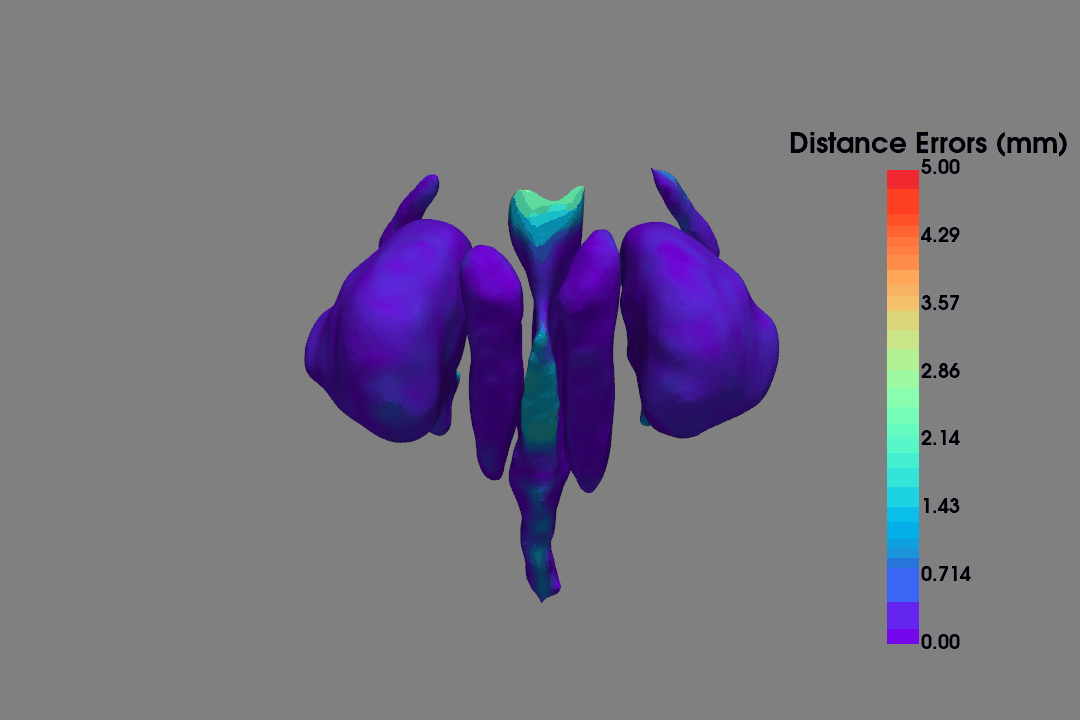[OTO–HNS2024] A Label-Efficient Framework for Automated Sinonasal CT Segmentation in Image-Guided Surgery
Manish Sahu*, Yuliang Xiao*, Jose L. Porras, Ameen Amanian, Aseem Jain, Andrew Thamboo, Russell H. Taylor, Francis X. Creighton, Masaru Ishii
* Indicates Equal Contribution
News | Abstract | Installation | Preprocess | Train | Inference
2024.06.07 - The data preprocessing, training, inference, and evaluation code are released.
2024.06.03 - Our paper is accepted to American Academy of Otolaryngology–Head and Neck Surgery 2024 (OTO-HNS2024).
-
Objective: Segmentation, the partitioning of patient imaging into multiple, labeled segments, has several potential clinical benefits but when performed manually is tedious and resource intensive. Automated deep learning (DL)-based segmentation methods can streamline the process. The objective of this study was to evaluate a label-efficient DL pipeline that requires only a small number of annotated scans for semantic segmentation of sinonasal structures in CT scans.
-
Methods: Forty CT scans were used in this study including 16 scans in which the nasal septum (NS), inferior turbinate (IT), maxillary sinus (MS), and optic nerve (ON) were manually annotated using an open-source software. A label-efficient DL framework was used to train jointly on a few manually labeled scans and the remaining unlabeled scans. Quantitative analysis was then performed to obtain the number of annotated scans needed to achieve submillimeter average surface distances (ASDs).
-
Results: Our findings reveal that merely four labeled scans are necessary to achieve median submillimeter ASDs for large sinonasal structures—NS (0.96 mm), IT (0.74 mm), and MS (0.43 mm), whereas eight scans are required for smaller structures—ON (0.80 mm).
-
Conclusion: We have evaluated a label-efficient pipeline for segmentation of sinonasal structures. Empirical results demonstrate that automated DL methods can achieve submillimeter accuracy using a small number of labeled CT scans. Our pipeline has the potential to improve preoperative planning workflows, robotic- and image-guidance navigation systems, computer-assisted diagnosis, and the construction of statistical shape models to quantify population variations.
 Figure 1: 3D Heatmap Visualization of Nasal Septum (NS), Inferior Turbinate (IT), Maxillary Sinus (MS), and Optic Nerve (ON)
Figure 1: 3D Heatmap Visualization of Nasal Septum (NS), Inferior Turbinate (IT), Maxillary Sinus (MS), and Optic Nerve (ON)
git clone https://github.com/mikami520/AutoSeg4SinonasalCT.gitpip install -r requirements.txt
source /path/to/VIRTUAL_ENVIRONMENT/bin/activate cd <path to repo>/deepatlas/preprocessCo-align the scans and labels (recommendation: similarity registration)
python registration_training.py
-bp <full path of base dir>
-ip <relative path to nifti images dir>
-sp <relative path to labels dir>
-ti <task id> If you want to make sure correspondence of the name and value of segmentations, you can add the following commands after above command (Option for nrrd format)
-sl LabelValue1 LabelName1 LabelValue2 LabelName2 LabelValue3 LabelName3 ...For example, if I have two labels for maxillary sinus named L-MS and R-MS and I want L-MS matched to label 1 and R-MS to label 2 (Pay attention to the order)
python registration_training.py -bp /Users/mikamixiao/Desktop -ip images -sp labels -sl 1 L-MS 2 R-MSFinal output of registered images and segmentations will be saved in
base_dir/deepatlas_raw_data_base/task_id/Training_dataset/images && base_dir/deepatlas_raw_data_base/task_id/Training_dataset/labels
Crop,normalize and flip data to extract region of interest (ROI). Notice: the images and segmentations should be co-registered. We recommend to use the outputs of Step 2.1
python crop_flip_training.py
-fp <if need to flip data, use flag for true and not use for false>
-ti <task id>
-rs <customized resized shape>Pay attention to the resized dimension which should not be smaller than cropped dimension
Final output of ROI will be saved in
base_dir/deepatlas_preprocessed/task_id/Training_dataset/images && base_dir/deepatlas_preprocessed/task_id/Training_dataset/labels
cd <path to repo>/deepatlas/scripts
python deep_atlas_train.py
--config <configuration file of network parameters>
--continue_training <check if need to resume training>
--train_only <only training or training plus test>
--plot_network <whether to plot the neural network architecture>For detailed information, use -h to see more instructions
Before training, a folder named deepatlas_results is created automatically under the repository directory. All training results are stored in this folder. A clear structure is shown below:
DeepAtlas/deepatlas_results/
├── Task001_ET
| └── results
| └── RegNet
| |── anatomy_loss_reg.txt
| |── anatomy_reg_losses.png
| |── reg_net_best.pth
| |── reg_net_training_losses.png
| |── regularization_loss.txt
| |── regularization_reg_losses.png
| |── similarity_loss_reg.txt
| |── similarity_reg_losses.png
| └── SegNet
| |── anatomy_loss_seg.txt
| |── anatomy_seg_losses.png
| |── seg_net_best.pth
| |── seg_net_training_losses.png
| |── supervised_loss_seg.txt
| |── supervised_seg_losses.png
| └── training_log.txt
| └── dataset.json
├── Task002_Nasal_Cavity
python deep_atlas_test.py
-gpu <id of gpu device to use>
-op <relative path of the prediction result directory>
-ti <task id and name>
The final prediction results will be saved in the DeepAtlas_dataset/Task_id_and_Name directory. For example,
DeepAtlas/DeepAtlas_dataset/
├── Task001_ET
| └── results
| └── RegNet
| |── anatomy_loss_reg.txt
| |── anatomy_reg_losses.png
| |── reg_net_best.pth
| |── reg_net_training_losses.png
| |── regularization_loss.txt
| |── regularization_reg_losses.png
| |── similarity_loss_reg.txt
| |── similarity_reg_losses.png
| └── SegNet
| |── anatomy_loss_seg.txt
| |── anatomy_seg_losses.png
| |── seg_net_best.pth
| |── seg_net_training_losses.png
| |── supervised_loss_seg.txt
| |── supervised_seg_losses.png
| └── training_log.txt
| └── prediction
| └── RegNet
| |── reg_img_losses.txt
| |── reg_seg_dsc.txt
| |── figures containing fixed, moving, warped scans deformation field and jacobian determinant
| |── warped scans and labels in nifti format
| └── SegNet
| |── seg_dsc.txt
| |── predicted labels in nifti format
| └── dataset.json
├── Task002_Nasal_Cavity


